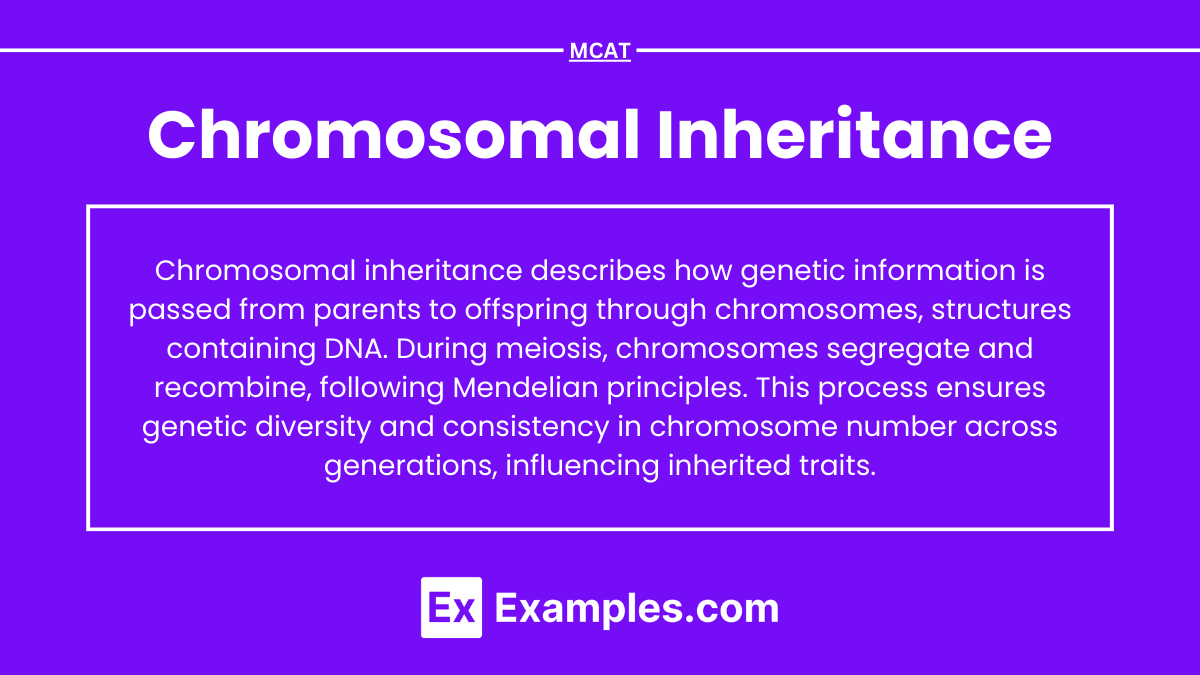Chromosomal Inheritance

- Notes
Preparing for the MCAT requires a solid understanding of chromosomal inheritance, crucial for mastering Genetic Systems. Gaining insights into chromosomal behavior during meiosis, patterns of inheritance, and genetic variation helps you grasp the fundamentals of genetic continuity and diversity, essential for excelling on the MCAT and understanding hereditary mechanisms in human health and disease.
Learning Objective
In studying “Chromosomal Inheritance” for the MCAT, you should develop an understanding of the principles underlying the transmission of genetic material through chromosomes, particularly during meiosis. Focus on concepts such as independent assortment, crossing over, and genetic linkage. Examine how alterations in chromosomal number or structure can lead to genetic disorders. Additionally, understand how these chromosomal mechanisms contribute to genetic diversity and influence traits across generations. Apply this knowledge to interpret pedigree analysis, genetic cross data, and MCAT practice questions focused on Mendelian and non-Mendelian inheritance patterns, as well as chromosomal anomalies impacting health.
1. Chromosome Structure and Function
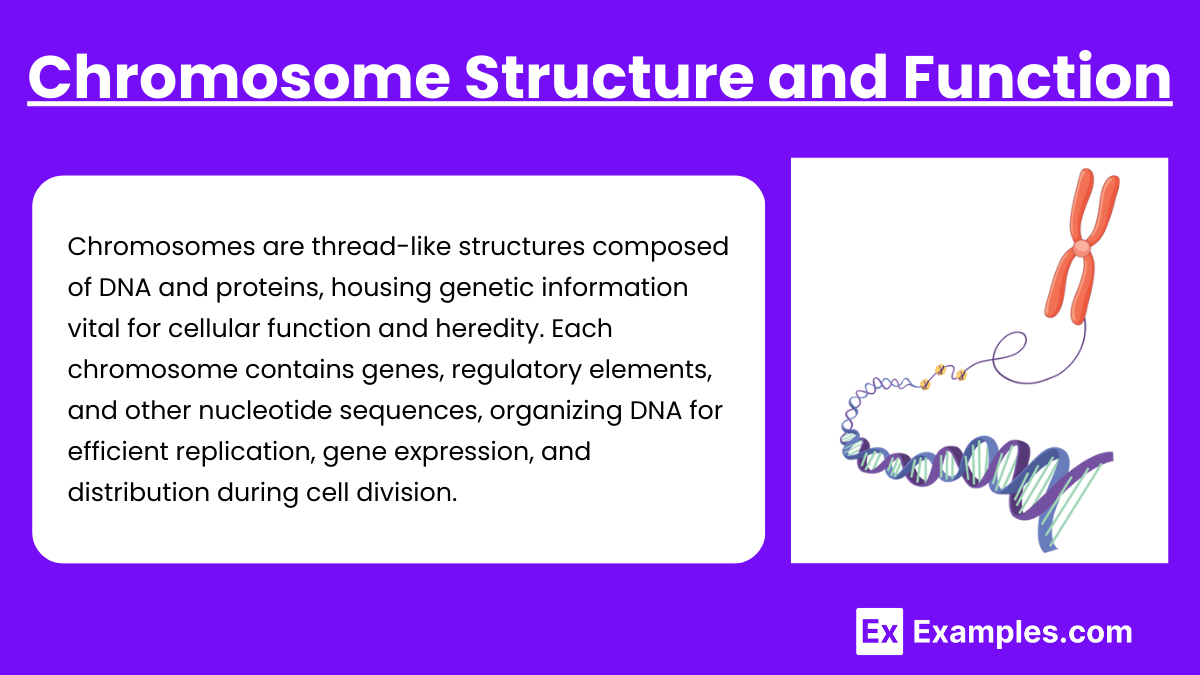
- Chromosomes are long strands of DNA wound around histone proteins, forming a complex structure called chromatin. During cell division, chromatin condenses into visible chromosomes to facilitate the accurate distribution of genetic material.
- In humans, there are 23 pairs of chromosomes (46 total), with 22 pairs being autosomes and one pair of sex chromosomes (XX for females and XY for males). Each chromosome pair is homologous, meaning they have similar structures and contain genes for the same traits, though they may carry different alleles.
- Genes are specific sequences of DNA located on chromosomes that code for proteins and determine various traits. Alleles are variations of a gene that contribute to the diversity of traits observed within a population.
2. Mendelian Inheritance Patterns
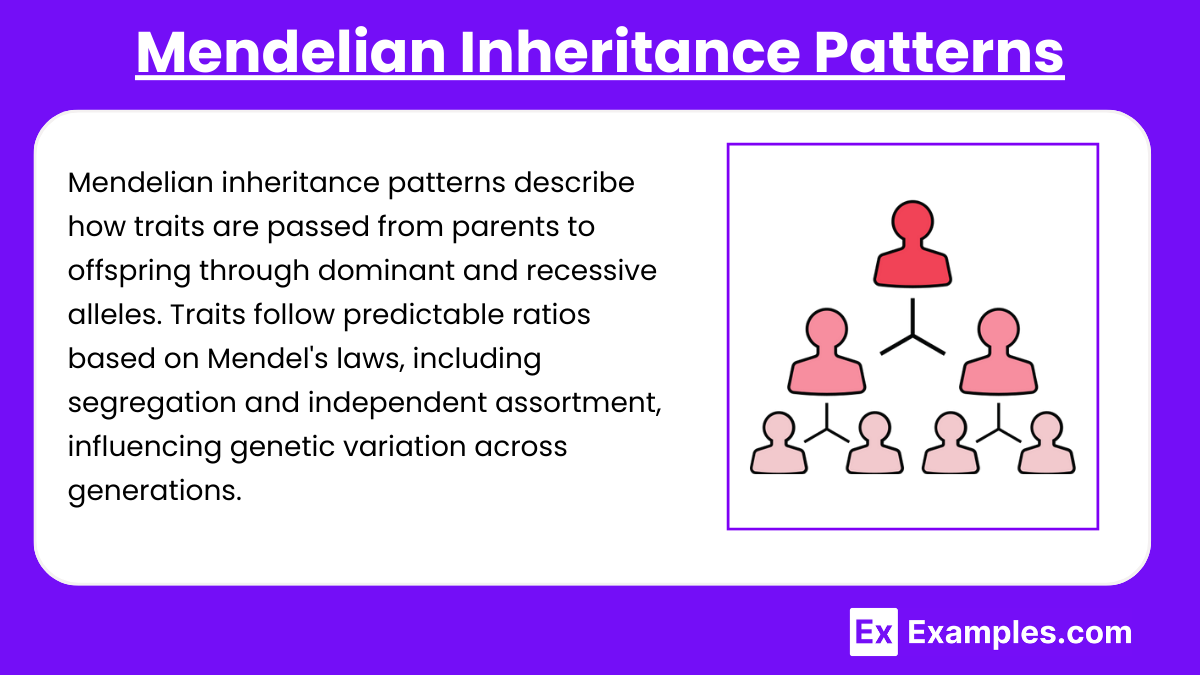
- Law of Segregation: Mendel’s first law states that during the formation of gametes (sperm and eggs), the two alleles for each gene segregate, or separate, so each gamete receives only one allele per gene. This ensures offspring inherit one allele from each parent.
- Law of Independent Assortment: Mendel’s second law explains that alleles of different genes assort independently during gamete formation. This means that the inheritance of one gene does not influence the inheritance of another, provided they are on different chromosomes or far apart on the same chromosome.
- Dominance and Recessiveness: In cases of simple dominance, dominant alleles mask the effect of recessive alleles in heterozygous individuals. Therefore, individuals with one dominant and one recessive allele (e.g., Aa) will express the dominant trait. Recessive traits are expressed only in homozygous recessive individuals (e.g., aa).
3. Non-Mendelian Inheritance Patterns
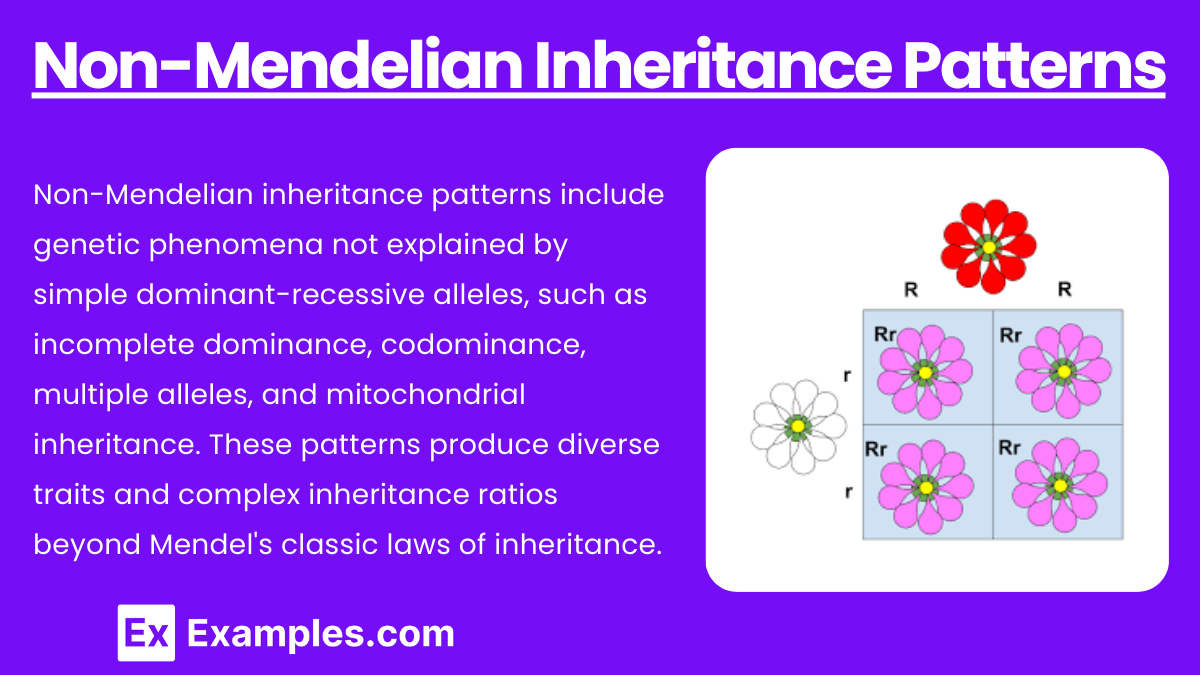
- Incomplete Dominance: This occurs when the heterozygous phenotype is a blend of both alleles. For example, in snapdragons, a cross between red (RR) and white (WW) flowers produces pink (RW) offspring.
- Codominance: In this pattern, both alleles in a heterozygous individual are fully expressed. A classic example is the ABO blood type system, where individuals with genotype AB express both A and B antigens.
- Multiple Alleles: While Mendelian genetics typically discusses two alleles per gene, some traits are governed by more than two alleles, contributing to a variety of phenotypes. The ABO blood group is governed by three alleles (IA, IB, and i).
4. Sex Chromosomes and Sex-Linked Traits
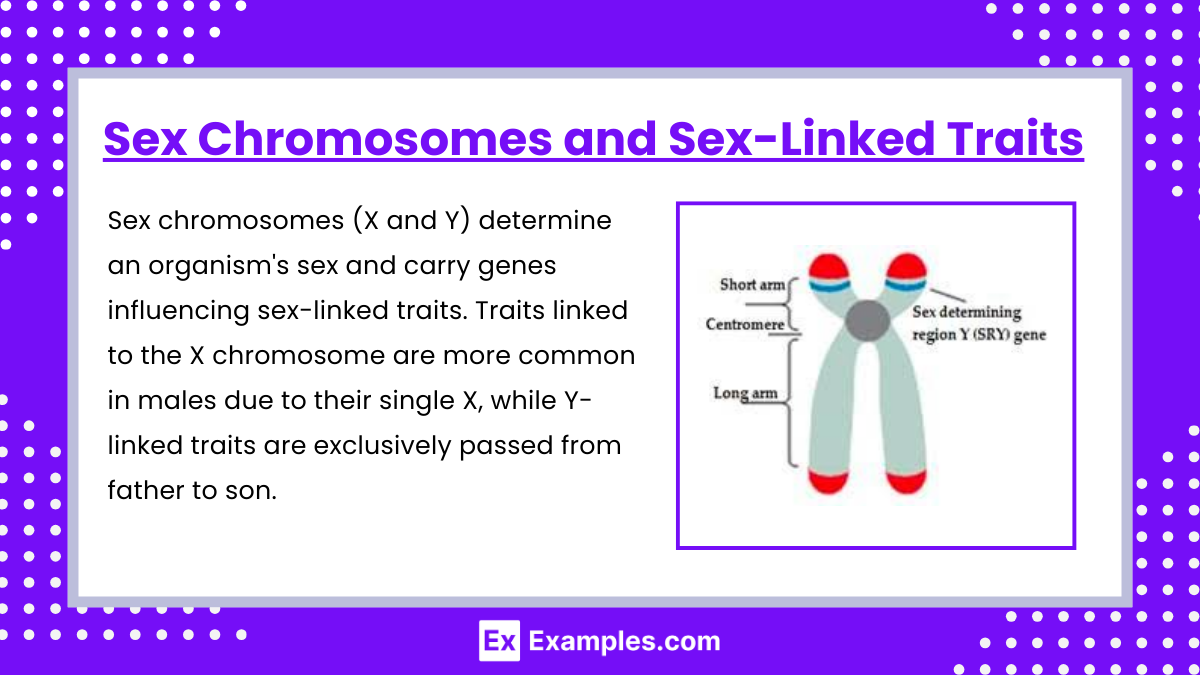
- Sex chromosomes (X and Y) differ in size and genetic content. The X chromosome is larger and carries more genes, while the Y chromosome is smaller with fewer genes, mostly related to male sex determination and development.
- X-Linked Traits: These are associated with genes on the X chromosome. Males are particularly susceptible to X-linked recessive disorders because they have only one X chromosome. Disorders like hemophilia and color blindness are X-linked; a male with one affected X chromosome will express the disorder, whereas females need two copies of the recessive allele to express it.
- Y-Linked Traits: Since only males possess a Y chromosome, Y-linked traits are passed exclusively from fathers to sons. These traits often involve male-specific development.
5. Chromosomal Disorders

- Aneuploidy: This refers to an abnormal number of chromosomes, typically resulting from nondisjunction during meiosis. Examples include Trisomy 21 (Down syndrome), where individuals have an extra copy of chromosome 21, and Turner syndrome, where females have a single X chromosome (45, X).
- Structural Abnormalities: These occur when segments of chromosomes are altered. Deletions remove a chromosome segment, as seen in Cri-du-chat syndrome (deletion on chromosome 5). Duplications involve the repetition of a segment, inversions flip a segment within a chromosome, and translocations occur when segments are exchanged between non-homologous chromosomes, such as in certain cancers.
Examples
Example 1: Mendel’s Law of Segregation
- During meiosis, homologous chromosomes separate so that each gamete receives only one allele of each gene.
- This principle helps explain how traits are passed from parents to offspring and why siblings can inherit different combinations of alleles.
Example 2: Independent Assortment
- Genes located on different chromosomes assort independently during meiosis.
- This process contributes to genetic variation by producing gametes with unique combinations of alleles, explaining the diversity seen in offspring.
Example 3: Crossing Over in Meiosis
- Homologous chromosomes exchange segments during meiosis, creating recombinant chromosomes with new allele combinations.
- This mechanism increases genetic diversity and is a critical factor in evolution by mixing genetic information from each parent.
Example 4: Chromosomal Abnormalities
- Errors in meiosis can lead to chromosomal abnormalities, such as trisomy (an extra chromosome) or monosomy (a missing chromosome).
- These abnormalities, like Down syndrome or Turner syndrome, often have significant effects on health and development.
Example 5: Sex-Linked Inheritance
- Genes located on the sex chromosomes (X and Y) exhibit unique inheritance patterns.
- For instance, X-linked recessive traits (e.g., hemophilia) are more commonly expressed in males, as they have only one X chromosome.
Practice Questions
Question 1:
Which of the following best explains why offspring exhibit a variety of genetic traits from their parents?
A) Chromosomes duplicate before cell division
B) Homologous chromosomes exchange genetic material during meiosis
C) The number of chromosomes remains constant after meiosis
D) The nuclear envelope dissolves during mitosis
Answer:
B) Homologous chromosomes exchange genetic material during meiosis
Explanation:
Crossing over between homologous chromosomes during meiosis creates new allele combinations, contributing to genetic diversity. This process is a key reason for variation in traits among offspring.
Question 2:
What occurs when chromosomes fail to separate properly during meiosis?
A) The organism may develop a third copy of a chromosome
B) Mitosis will fail to proceed
C) All resulting gametes are genetically identical
D) DNA replication fails to complete
Answer:
A) The organism may develop a third copy of a chromosome
Explanation:
Nondisjunction, the failure of chromosomes to separate, can result in aneuploidy, where an individual has an extra chromosome (trisomy) or a missing chromosome (monosomy), leading to genetic disorders.
Question 3:
Which statement accurately describes sex-linked inheritance?
A) Traits linked to the Y chromosome are equally expressed in males and females
B) X-linked recessive traits are more commonly expressed in females
C) Y-linked traits are passed only from father to son
D) Males have two X chromosomes, one from each parent
Answer:
C) Y-linked traits are passed only from father to son
Explanation:
Y-linked traits are inherited through the Y chromosome, which only males possess, ensuring these traits are exclusively passed from father to son.
Preparing for the MCAT requires a solid understanding of chromosomal inheritance, crucial for mastering Genetic Systems. Gaining insights into chromosomal behavior during meiosis, patterns of inheritance, and genetic variation helps you grasp the fundamentals of genetic continuity and diversity, essential for excelling on the MCAT and understanding hereditary mechanisms in human health and disease.
Learning Objective
In studying "Chromosomal Inheritance" for the MCAT, you should develop an understanding of the principles underlying the transmission of genetic material through chromosomes, particularly during meiosis. Focus on concepts such as independent assortment, crossing over, and genetic linkage. Examine how alterations in chromosomal number or structure can lead to genetic disorders. Additionally, understand how these chromosomal mechanisms contribute to genetic diversity and influence traits across generations. Apply this knowledge to interpret pedigree analysis, genetic cross data, and MCAT practice questions focused on Mendelian and non-Mendelian inheritance patterns, as well as chromosomal anomalies impacting health.
1. Chromosome Structure and Function

Chromosomes are long strands of DNA wound around histone proteins, forming a complex structure called chromatin. During cell division, chromatin condenses into visible chromosomes to facilitate the accurate distribution of genetic material.
In humans, there are 23 pairs of chromosomes (46 total), with 22 pairs being autosomes and one pair of sex chromosomes (XX for females and XY for males). Each chromosome pair is homologous, meaning they have similar structures and contain genes for the same traits, though they may carry different alleles.
Genes are specific sequences of DNA located on chromosomes that code for proteins and determine various traits. Alleles are variations of a gene that contribute to the diversity of traits observed within a population.
2. Mendelian Inheritance Patterns

Law of Segregation: Mendel’s first law states that during the formation of gametes (sperm and eggs), the two alleles for each gene segregate, or separate, so each gamete receives only one allele per gene. This ensures offspring inherit one allele from each parent.
Law of Independent Assortment: Mendel’s second law explains that alleles of different genes assort independently during gamete formation. This means that the inheritance of one gene does not influence the inheritance of another, provided they are on different chromosomes or far apart on the same chromosome.
Dominance and Recessiveness: In cases of simple dominance, dominant alleles mask the effect of recessive alleles in heterozygous individuals. Therefore, individuals with one dominant and one recessive allele (e.g., Aa) will express the dominant trait. Recessive traits are expressed only in homozygous recessive individuals (e.g., aa).
3. Non-Mendelian Inheritance Patterns

Incomplete Dominance: This occurs when the heterozygous phenotype is a blend of both alleles. For example, in snapdragons, a cross between red (RR) and white (WW) flowers produces pink (RW) offspring.
Codominance: In this pattern, both alleles in a heterozygous individual are fully expressed. A classic example is the ABO blood type system, where individuals with genotype AB express both A and B antigens.
Multiple Alleles: While Mendelian genetics typically discusses two alleles per gene, some traits are governed by more than two alleles, contributing to a variety of phenotypes. The ABO blood group is governed by three alleles (IA, IB, and i).
4. Sex Chromosomes and Sex-Linked Traits

Sex chromosomes (X and Y) differ in size and genetic content. The X chromosome is larger and carries more genes, while the Y chromosome is smaller with fewer genes, mostly related to male sex determination and development.
X-Linked Traits: These are associated with genes on the X chromosome. Males are particularly susceptible to X-linked recessive disorders because they have only one X chromosome. Disorders like hemophilia and color blindness are X-linked; a male with one affected X chromosome will express the disorder, whereas females need two copies of the recessive allele to express it.
Y-Linked Traits: Since only males possess a Y chromosome, Y-linked traits are passed exclusively from fathers to sons. These traits often involve male-specific development.
5. Chromosomal Disorders

Aneuploidy: This refers to an abnormal number of chromosomes, typically resulting from nondisjunction during meiosis. Examples include Trisomy 21 (Down syndrome), where individuals have an extra copy of chromosome 21, and Turner syndrome, where females have a single X chromosome (45, X).
Structural Abnormalities: These occur when segments of chromosomes are altered. Deletions remove a chromosome segment, as seen in Cri-du-chat syndrome (deletion on chromosome 5). Duplications involve the repetition of a segment, inversions flip a segment within a chromosome, and translocations occur when segments are exchanged between non-homologous chromosomes, such as in certain cancers.
Examples
Example 1: Mendel’s Law of Segregation
During meiosis, homologous chromosomes separate so that each gamete receives only one allele of each gene.
This principle helps explain how traits are passed from parents to offspring and why siblings can inherit different combinations of alleles.
Example 2: Independent Assortment
Genes located on different chromosomes assort independently during meiosis.
This process contributes to genetic variation by producing gametes with unique combinations of alleles, explaining the diversity seen in offspring.
Example 3: Crossing Over in Meiosis
Homologous chromosomes exchange segments during meiosis, creating recombinant chromosomes with new allele combinations.
This mechanism increases genetic diversity and is a critical factor in evolution by mixing genetic information from each parent.
Example 4: Chromosomal Abnormalities
Errors in meiosis can lead to chromosomal abnormalities, such as trisomy (an extra chromosome) or monosomy (a missing chromosome).
These abnormalities, like Down syndrome or Turner syndrome, often have significant effects on health and development.
Example 5: Sex-Linked Inheritance
Genes located on the sex chromosomes (X and Y) exhibit unique inheritance patterns.
For instance, X-linked recessive traits (e.g., hemophilia) are more commonly expressed in males, as they have only one X chromosome.
Practice Questions
Question 1:
Which of the following best explains why offspring exhibit a variety of genetic traits from their parents?
A) Chromosomes duplicate before cell division
B) Homologous chromosomes exchange genetic material during meiosis
C) The number of chromosomes remains constant after meiosis
D) The nuclear envelope dissolves during mitosis
Answer:
B) Homologous chromosomes exchange genetic material during meiosis
Explanation:
Crossing over between homologous chromosomes during meiosis creates new allele combinations, contributing to genetic diversity. This process is a key reason for variation in traits among offspring.
Question 2:
What occurs when chromosomes fail to separate properly during meiosis?
A) The organism may develop a third copy of a chromosome
B) Mitosis will fail to proceed
C) All resulting gametes are genetically identical
D) DNA replication fails to complete
Answer:
A) The organism may develop a third copy of a chromosome
Explanation:
Nondisjunction, the failure of chromosomes to separate, can result in aneuploidy, where an individual has an extra chromosome (trisomy) or a missing chromosome (monosomy), leading to genetic disorders.
Question 3:
Which statement accurately describes sex-linked inheritance?
A) Traits linked to the Y chromosome are equally expressed in males and females
B) X-linked recessive traits are more commonly expressed in females
C) Y-linked traits are passed only from father to son
D) Males have two X chromosomes, one from each parent
Answer:
C) Y-linked traits are passed only from father to son
Explanation:
Y-linked traits are inherited through the Y chromosome, which only males possess, ensuring these traits are exclusively passed from father to son.

